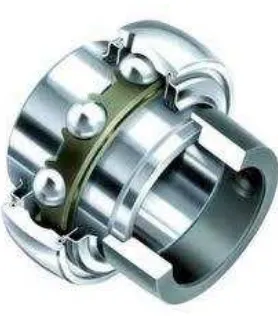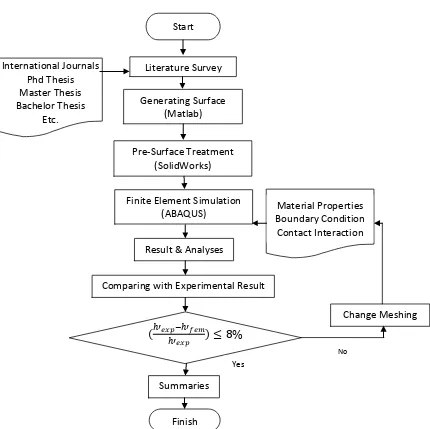Chapter 1
Introduction
1.1.Background
In most of every case of daily life we meet tribology phenomena. Any product where
one material slides or rubs over another is affected by complex tribological interactions.
Tribology plays an important role in manufacturing. In metal-forming operations,
friction increases tool wear and the power required to work a piece. This results in
increased costs due to more frequent tool replacement, loss of tolerance as tool
dimensions shift, and greater forces required to shape a piece. The study of tribology is
commonly applied in bearing design (Fig. 1.1) but extends into almost all other aspects
of modern technology, even to such unlikely areas as biomaterial of hip joint and
cosmetics such as lipstick, hair conditioner, powders and lipgloss. Tribology is the
science and engineering of interacting surfaces in relative motion and of related subjects
and practices. It describes phenomena in friction, wear, and lubrication.
Figure 1.1: Spherical ball bearing manufactured by Schaeffler Technologies GmbH &
Co. KG – INA [1].
Topography of surface determines the condition of wear. Rough surfaces
usually wear more quickly and have higher friction coefficients than smooth surfaces.
environment. The contact behavior of rough surface is sensitive to surface topography.
A small change in the distribution of the heights, widths, and curvatures of the asperity
peaks can have a noticeable effect on the deformation behaviors of the rough surface.
Even a highly polished surface has surface roughness on many different length
scales. When two bodies with nominally flat surfaces are brought into contact, the area
of real contact will usually only be a small fraction of the nominal contact area (Fig
1.2). We can visualize the contact regions as small areas where asperities from one solid
are squeezed against asperities of the other solid; depending on the conditions the
asperities may deform elastically or plastically [2].
Figure 1.2: Contact between two rough surfaces [2].
In the past, numerous authors made study on rough surface. The classical
analysis makes simplifying assumptions about the surface topography and deformation
behavior. Traditionally, surfaces were modeled analytically using assumption and
simplifications. Asperities were modeled as a variety of geometric shapes. Surface
asperity height and contact pattern were treated as probability distributions. The
behavior of a single pair of interacting asperities was often extrapolated to describe the
behavior of a pair of interacting surfaces covered in asperities [3]. These assumptions
were not made because they were shown to accurately represent the system of interest,
but because they made modeling possible. In the 1950’s and 60’s when much of this
microscopically rough surfaces and the changes occur under load and relative motion
are the important parameters in understanding many tribological phenomena, such as
stiffness of joints, wear, adhesion, friction force, frictional heating, thermal and
electrical contact resistance and fluid leakage.
Until nowadays, surface roughness effects were ignored in the analysis, due to
the difficulty to generate a rough surface model and also to simplify the model in order
to reduce calculation time. However, many engineering fields, such as MEMS, seek to
improve the behavior of the system at the surface level or the interface between
surfaces. Thus, with the advance of numerical capabilities, the topography of the surface
can be included in finite element simulations.
1.2Objectives
The study of a single asperity and of a periodic microstructure of identical asperities
provides us with a deep understanding of the local deformation process. However the
global deformation is much more complicated: asperity shapes are not so simple as it
has been considered, the width, height and vertical position follow distribution rules
and, due to the fractal nature of rough surfaces. Simple geometrical and analytical
models cannot account for all these aspects. So, full scale finite element analyses are
needed to better understand the global deformation of rough surface.
A surface geometry of many components and systems is not always known and
not always be measured. This condition make study of real surface was hard to
accomplish. Numerical contact simulations of rough surfaces are common but most
models contain extensive assumptions and idealizations about asperity shape and size.
This work presents a new method for generating deterministic of rough surface in
ABAQUS with pre- treatment in SolidWorks. A method that never been done before by
any tribologist. Random geometry of a real rough surface and a deformable smooth ball
is then taken for simulating real rough surface contact using finite element analysis.
These techniques, combined with the ability to model real surfaces in ABAQUS, can be
used to help researchers in material science, mechanical engineering, and beyond to
The objectives of the present study are framed as follows:
1. Generating three dimensional models of rough surfaces in commercial finite
element software.
2. Verify generated surface with normal surface on ABAQUS.
3. Applying generated surface in static case of elastic and elastic plastic contact.
4. Comparing finite element model with experiment model.
1.3 Constrains
This study is a single step ahead to predict the real situation by modeling the contact
problem, yet modeling that carried out surely have limitation compared with the real
situation. Therefore, it is necessary to apply several constrain on this paper.
a) The real rough surface data is retrieved by using 3D coordinate data from
measured surface, yet random rough surface that is made in this study is taken
from mathematical equation.
b) Surface simulation only covered elastic plastic condition on static contact.
c) All contact interactions that occur in the study here is a dry contact which means
it does not consider the presence of lubricant.
d) Material properties in this study are aluminum.
e) Thermal due to friction is ignored.
f) Surface generated under finite element commercial ABAQUS 6.10-1, Matlab
R2008a, and SolidWorks 2010.
1.4 Research Methodology
As shown in Figure 1.3. the research is started from literature survey from numerous
works by many researchers. Furthemore, author analyze a particular case that have been
done before as literature data. Result from simulation compared with experimental data
using commercial finite element software ABAQUS 6.10-1. Study was done to analyze
simulation result under supervising from supervisor. Summary was taken from
analyzing process aim to completed previous model of rough surface with alumunium
Figure 1.3: Research methodology flowchart.
1.5 Systematic of Writing
At the first chapter there will be explanation containing background, the importance of
topic, objectives, constrains, method research methodology and systematic of writing.
The main discussion on this thesis is contact of rough surface. Therefore, second
completed with previous works from many researchers in the same field. The way this
work modeled is explained in third chapter.
Chapter three discusses the modeling procedure of rough surfaces. A little
introduction of finite element method (FEM) is presented before describing the
modeling procedure. Several software such Matlab, SolidWorks, and ABAQUS is
involved in generating process. All of the result from this works is presented in chapter
four. Sinusoidal and random rough surface is loaded both in condition of elastic and
elastic-plastic. Validation of this work is illustrated on comparison between
experimental surfaces with FEM. Conclusion of this work and some recomendation for
thoose who insist to continue research on this field lies on chapter fifth.
References
1.
http://www.directindustry.com/prod/schaeffler-technologies-ag-co-kg-ina/spherical-ball-bearings-169-54665.html (8 January 2012).
2. Persson, B.N.J., Bucher, F., and Chiaia, B., 2002, Elastic contact between
randomly rough surfaces: comparison of theory with numerical tesults, Physical
Review B, 65(18), pp. 184-196.
3. Thompson, M. K., 2007, A Multi-scale Iterative Approach for Finite Element
Modeling of Thermal Contact Resistance, Ph.D. Thesis, Massachusetts Institute

![Figure 1.2: Contact between two rough surfaces [2].](https://thumb-ap.123doks.com/thumbv2/123dok/2244550.1231907/2.595.276.412.324.496/figure-contact-rough-surfaces.webp)
